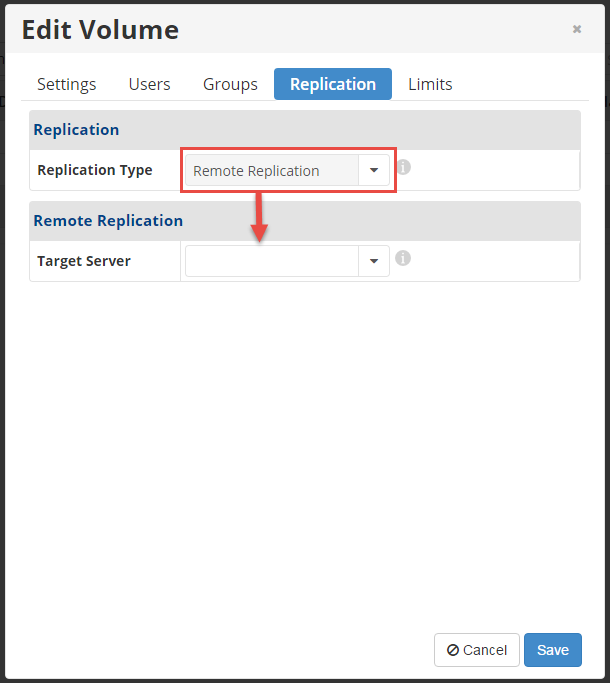| Site-to-Site is a licensed feature Site-to-Site replication uses license count on the target Backup Manager for each protected machine that is replicated. |
Site-to-Site Replication
Introduced in Server Backup Manager 5.10.0, Site-to-Site Replication allows administrators to replicate backup data contained in Volumes and Disk Safes to another SBM server. Once enabled and configured, all backup data is automatically replicated to the remote SBM servers. The replication data travels across the network using SSL encryption regardless of Disk Safe encryption settings. This technology allows administrators to transparently store data across SBM servers, even in different geographic locations. Administrators can also use the replicated data to directly restore protected servers.
With Site-to-Site Replication, the SBM server is associated with one or more SBM servers. Then at the Volume storage level, you can specify Remote Replication. With your next recovery point execution, you'll see the Disk Safe data transferred to the target server.
One feature of Site-to-Site Replication is the ability to use the replicated Disk Safes to directly restore the protected servers. So if your primary SBM server is offline, a backup restoration is still just a few clicks away.
| Known Issues Site-to-Site (remote replication) Disk Safe replication tasks for Windows protected machines using Dynamic Disks may fail with protocol errors when replicating partition tables. Site-to-Site replication between a 5.12+ SBM server and an older server is not possible due to SSL library changes. |
Accessing Site-to-Site Replication Settings
All Site-to-Site Replication settings are available within the SBM web interface. They are accessed by clicking Remote Replication Options in the Advanced Options section of the Main Menu. The configuration interface is grouped into three areas: Remote Replication Listener Options, Outbound Remote Replication Options, and Target Servers.
- Remote Replication Listener Options are settings related to allowing the SBM server receive replication data.
- Outbound Remote Replication Options control authentication and network settings for sending replication data.
- Target Servers is used to specify the receiving servers of replication data sent from the SBM server.
Each configuration setting within the three configuration areas includes additional help information to guide the administrator in setting correct values.
For more information about the Remote Replication Options screen, click here.
Target SBM Server Configuration
A server which will receive replication data must be configured to listen for replication requests. This is configured in the Remote Replication Options screen. The Enabled check box must be selected, and any additional settings should be configured if the default values are not appropriate for the environment.
You must specify the location of replicated data. This can be specified using the Default Replication Path field. All replicated data will be stored at the location entered in this field.
Sending SBM Server Configuration
The SBM server which will be sending replication data can be configured to specify authentication and network settings appropriate for the environment. These settings can be found in the Outbound Remote Replication Options section.
The sending SBM server must be associated with target SBM servers in the Target Servers configuration area. When adding a target server, the administrator must provide the following information in the Add Target Server window:
- Name - a user defined alias for display purposes
- Host Name/IP - a resolvable network name or IP address for the target server
- Port Number - the specific listening port for replication requests
- Username - the administrative account username on the target SBM server
- Password - the administrative account password on the target SBM server
- API Port - the SOAP API port on the target SBM server
- Use SSL - setting allowing the administrator to control specify whether the SOAP API uses SSL network encryption (found in Advanced Options > API Server Options of the target SBM server)
Replicating SBM Server Data
Backup data is replicated at the Volume or Disk Safe level. In order to replicate a Volume or Disk Safe, replication must be enabled within the Volume or Disk Safe. These settings can be found in the Replication tab of the Edit Volume or Edit Disk Safe windows in the user interface. Once you have selected Remote Replication in the Replication Type field, the Target Server field displays, where you can specify the target server configured earlier in the Outbound Remote Replication Options section.

Site-to-Site Replication occurs automatically once configured. All backup tasks resulting in changes to the Volumes or Disk Safes are propagated to the remote SBM server. Replicated data is stored on the target SBM server within the directory specified in its Remote Replication Options in the Default Replication Path field.
Remote Replication happens after the local archive runs.
